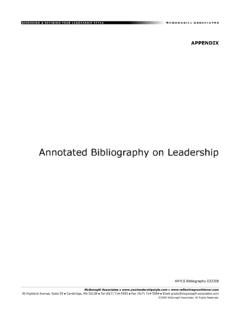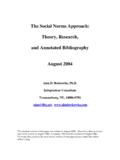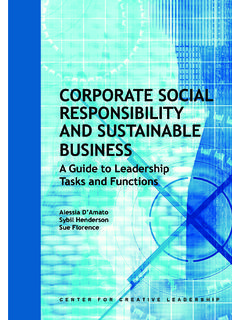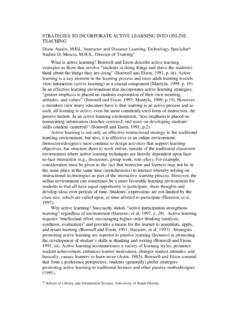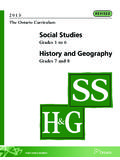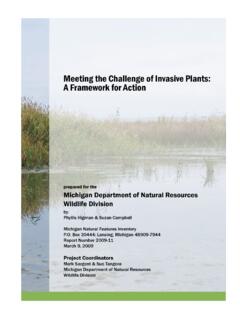Transcription of At A Glance: What We Know about The Effects of …
1 At A Glance: What We Know aboutThe Effects of Service-Learning on CollegeStudents, Faculty, Institutions and Communities, 1993-2000: Third S. Eyler, Dwight , Jr., Christine M. Stenson, and Charlene J. GrayVanderbilt UniversityAugust 31, 2001 Funded by the Corporation for National ServiceLearn and Serve America National Service Learning Clearinghouse"At A Glance" summarizes the findings of service-learning research in highereducation over the past few years and includes an annotated bibliography. Itis designed to provide a quick overview of where we are in the field todayand a map to the We Know: The Effects of Service-LearningOn StudentsA. Personal Outcomes Service-learning has a positive effect on student personal development such assense of personal efficacy, personal identity, spiritual growth, and moraldevelopment:Astin & Sax, 1998; Astin, Sax, & Avalos, 1999; Blackwell, 1996 (dissertation); Boss, 1994; Driscoll,Holland, Gelmon, & Kerrigan, 1996; Eyler, Giles, & Braxton, 1997; Eyler & Giles, 1999; Fenzel &Leary, 1997; Freidus, 1997; Giles & Eyler, 1994; Gray, Ondaatje, Fricker, Geschwind, Goldman,Kaganoff, Robyn, Sundt, Vogelgesang, & Klein, 1998; Greene, 1996 (dissertation); Gorman, 1994;Ikeda, 1999 (dissertation); Jordan, 1994 (dissertation); Keen, & Keen, 1998; Kendrick, 1996; Loewen,1998 (dissertation); Markus, Howard, & King 1993; McMahon, 1998; Ostrow, 1995; Peterson, 1998;Rauner, 1995 (dissertation); Rhoads, 1997; Rockquemore & Schaffer 2000; Schmidt, 2000; Seibold,1998 (dissertation); Sledge, Shelburne, & Jones,1993; Vogelgesang & Astin, 2000; VCU, 1997.
2 Wade &Yarborough, 1996; Wang, 2000; Western Washington University, 1994. Service-learning has a positive effect on interpersonal development and theability to work well with others, leadership and communication skills:Astin & Sax, 1998; Bacon, 1997 (dissertation); Dalton & Petrie, 1997; Driscoll, Holland, Gelmon, &Kerrigan, 1996; Eyler & Giles, 1999; Freidus, 1997; Giles & Eyler, 1994; Gray, et al., 1998; Juhn,Tang, Piessens, Grant, Johnson, & Murray, 1999; Keen, & Keen, 1998; Knee, 1999 (dissertation);Mabry, 1998; McElhaney, 1998 (dissertation); McMahon, 1998; Raskoff, 1997; Rauner, 1995(dissertation); Rhoads, 1997; Seibold, 1998 (dissertation); Sledge, Shelburne, & Jones, 1993; Peterson,1998; Tarallo-Falk, 1995 (dissertation); Vogelgesang & Astin, 2000; Wade &Yarborough, 1996;Zawacki, 1997 (dissertation).B. Social Outcomes Service-learning has a positive effect on reducing stereotypes and facilitatingcultural & racial understanding:Astin & Sax, 1998; Astin, Sax, & Avalos, 1999; Balazadeh, 1996; Barber, Higgins, Smith, Ballou,Dedrick, & Downing, 1997; Boyle-Baise, 1998; Boyle-Baise & Kilbane, 2000; Bringle & Kremer, 1993;Driscoll, Holland, Gelmon, & Kerrigan, 1996; Dunlap, 1997; Dunlap, 1998; Eyler, Giles & Braxton,1997; Eyler & Giles, 1999; Fenzel & Leary, 1997; Giles & Eyler, 1994; Gray, et al.
3 1998; Greene &Diehm, 1995; Greene, 1996 (dissertation); Hones, 1997; Jordan, 1994 (dissertation); Keen & Keen,1998; Kendrick, 1996; McElhaney, 1998 (dissertation); Myers-Lipton, 1996a; Myers-Lipton, 1996b;Ostrow, 1995; Pickron-Davis 1999 (dissertation); Potthoff, Dinsmore, Eifler, Stirtz, Walsh, &2 Ziebarth, 2000; Rauner, 1995 (dissertation); Rhoads, 1997; Vogelgesang & Astin, 2000; VirginiaCommonwealth University, 1997; Western Washington University, 1994. Service-learning may subvert as well as support course goals of reducingstereotyped thinking and facilitating cultural & racial understanding:Curran, 1999; Grady, 1998; Pickron-Davis 1999 (dissertation). Service-learning has a positive effect on sense of social responsibility andcitizenship skills:Astin & Sax, 1998; Astin, Sax, & Avalos, 1999; Barber, Higgins, Smith, Ballou, Jeffrey, Dedrick, &Downing, 1997; Batchelder & Root, 1994; Dalton & Petrie, 1997; Driscoll, Holland, Gelmon, &Kerrigan, 1996; Eyler & Giles, 1999; Eyler, Giles & Braxton, 1997; Fenzel & Leary, 1997; Giles &Eyler, 1994; Gray, et al.
4 1998; Johnson & Bozeman, 1998; Keen, & Keen, 1998; Kendrick, 1996;Mabry, 1998; McElhaney, 1998 (dissertation); Myers-Lipton, 1998; Nnakwe, 1999; Ostrow, 1995;Rice & Brown, 1998; Sledge, Shelburne, & Jones, 1993; Rhoads, 1997; VCU, 1997. Service-learning has a positive effect on commitment to service:Astin & Sax, 1998; Astin, Sax, & Avalos, 1999; Blackwell, 1996 (dissertation), Driscoll, Holland,Gelmon, & Kerrigan, 1996; Eklund-Leen, 1994 (dissertation); Eyler & Giles, 1999; Eyler, Giles &Braxton, 1997; Fenzel & Leary, 1997; Giles & Eyler, 1994; Greene, 1996 (dissertation); Keen, & Keen,1998; Kolcross, 1997 (dissertation); Markus, Howard, King, 1993; McElhaney, 1998 (dissertation);Nnakwe, 1999; Oliver, 1997; Payne, 2000; Payne, & Bennett, 1999; Potthoff, Dinsmore, Eifler, Stirtz,Walsh, & Ziebarth, 2000; Rauner, 1995 (dissertation); Rhoads, 1997; Smedick, 1996 (dissertation);Stukas & Clary, 1998; Tartter, 1996; Western Washington University, 1994; Vogelgesang & Astin,2000.
5 Volunteer service in college is associated with involvement in communityservice after graduation:Astin, Sax, & Avalos, 1999; Smedick, 1996 (dissertation).3C. Learning Outcomes Students or faculty report that service-learning has a positive impact onstudents' academic learning:Astin & Sax, 1998; Balazadeh, 1996; Blackwell, 1996 (dissertation); Boss, 1994; Burr, 1997(dissertation); Cohen & Kinsey, 1994; Driscoll, Holland, Gelmon, & Kerrigan, 1996; Eyler & Giles,1999; Eyler, Root, & Giles, 1998; Fenzel & Leary, 1997; Foreman, 1996; Gelmon, Holland, andShinnamon, 1998; Greene, 1996 (dissertation); Hall, 1996(dissertation); Jordan, 1996 (dissertation);Hesser, 1995; Knee, 1999; Markus, Howard & King, 1993; McElhaney, 1998 (dissertation);McMahon, 1998; Miller, 1994; Oliver, 1997; Schmiede, 1995; Sledge, Shelburne, & Jones, 1993;Soukup, 1999; Strage, 2000; Tarallo-Falk, 1995 (dissertation); Vogelgesang & Astin, 2000; VCU, 1997;Ward, 2000; Western Washington University, 1994.
6 Students or faculty report that service-learning improves students' ability toapply what they have learned in the real world :Bacon, 1997 (dissertation); Balazadeh, 1996; Cohen & Kinsey 1994; Eyler & Giles, 1999; Fenzel &Leary, 1997; Foreman, 1996; Gelmon, Holland, and Shinnamon, 1998; Gray, et al., 1998; Hall, 1996(dissertation); Juhn, Tang, Piessens, Grant, Johnson, & Murray, 1999; Kendrick, 1996; Oliver, 1997;Markus, Howard, & King, 1993; McElhaney, 1998 (dissertation); McMahon, 1998; Miller, 1994;Nigro & Wortham, 1998; VCU, 1997. The impact of service-learning on student academic learning as measured bycourse grades or GPA is mixed:Some studies have shown a positive impact of community service on academiclearning:Astin & Sax, 1998; Tartter, 1996; Vogelgesang & Astin, studies have shown a positive impact of service-learning on academiclearning:Gray et al., 1998; Markus, Howard, & King, 1993; Strage, 2000; Vogelgesang & Astin, studies show differences in academic learning between service- learning and non service-learning students, but calculate grades differently for these two groups of students:Balazadah, 1996; Berson & Younkin, 1998; Shastri, studies show no difference between service-learning and non- service-learning control groups in academic learning:Boss, 1994; Hudson, 1996; Kendrick, 1996; Miller, 1994; Parker-Gwin & Mabry, 1998.
7 Service-learning participation has an impact on such academic outcomes asdemonstrated complexity of understanding, problem analysis, criticalthinking, and cognitive development:Batchelder & Root, 1994; Eyler & Giles, 1999; Eyler, Root, & Giles, 1998; Osborne, Hammerich,Hensley, 1998. The impact of service-learning on student cognitive moral development ismixed: Some studies find that service-learning contributes to moral development:Boss, 1994; Gorman, studies show no difference in moral development between service-learning and non- service-learning control groups:Cram, 1998; Fenzel & Leary, 1997; Greene, Career Development Service-learning contributes to career developmentAstin & Sax, 1998; Astin, Sax, & Avalos, 1999; Aultman, 1997 (dissertation); Driscoll, Holland,Gelmon, & Kerrigan, 1996; Fenzel & Leary, 1997; Greene & Diehm, 1995; Juhn, Tang, Piessens,Grant, Johnson, & Murray, 1999; Keen, & Keen, 1998; McElhaney, 1998 (dissertation); Sledge,Shelburne, & Jones, 1993; Smedick, 1996 (dissertation); Tartter, 1996; Vogelgesang & Astin, 2000;VCU, 1997.
8 Western Washington University, Relationship with Institution Students engaged in service-learning report stronger faculty relationships thanthose who are not involved in service-learning:Astin & Sax, 1998; Gray et al, 1998; Eyler & Giles, 1999. Service-learning improves student satisfaction with college:Astin & Sax, 1998; Berson & Younkin, 1998; Gray, et al., 1998. Students engaged in service-learning are more likely to graduate:Astin & Sax, 1998; Roose, Daphne, Miller, Norris, Peacock, White, & White, Processes examined in Qualitative is a growing body of case studies that describe service-learning processesand contexts. Themes explored include: Citizenship developmentDalton & Petrie, 1997; Smith, 1994. Dealing with diversityBoyle-Baise, 1998; Boyle-Baise & Kilbane 2000; Dunlap, 1998a; Hones, 1997; Pickron-Davis, 1999(dissertation); Rockquemore & Schaffer, 2000; Skilton-Silvester & Erwin, 2000. Institutional support and cohesionWard K.
9 , 1996. Transformations in orientations toward service and communityBacon, 1997(dissertation); Dunlap 1998b; Ostrow, 1995; Rockquemore & Schaffer 2000; Schmidt,2000 (dissertation); Tarallo-Falk, 1995 (dissertation); Wade & Yarborough, 1996. Reflection and instructional processesFreidus, 1997; Hall, 1996 (dissertation); Hones, 1997; Ikeda, 2000; Ikeda, 1999 (dissertation);Schmiede, 1995. Self and identityDunlap, 1997; Rhoads, 1997; Wang, What We Know: The Effects of Particular Program Characteristics onStudentsA. Placement Quality Placement quality has a positive impact on student personal and interpersonaloutcomes:Eyler & Giles, 1999; Mabry, Reflection Quality and quantity of reflective activities have an impact on studentlearning:Eyler & Giles, 1999; Gray, et al. 1998; Greene & Diehm, 1995; Ikeda, 1999 (dissertation); Loewen,1998 (dissertation); Mabry, Application of service Application of service to academic content and vice versa has an impact onstudents, particularly learning outcomes:Boss, 1994; Batchelder & Root, 1994; Eyler & Giles, 1999; McElhaney, Duration and Intensity of Service Duration and intensity of service have an impact on student outcomes:Astin & Sax, 1998; Astin, Sax, & Avalos, 1999; Mabry, Exposure to Diversity Diversity has an impact on students, particularly personal outcomes, such asidentity development & cultural understanding:Eyler & Giles, 1999; Gray, et al.
10 , 1998; Pickron-Davis, 1999 (dissertation).7F. Community voice Community voice in a service-learning project has an impact on studentcultural understanding:Eyler & Giles, 1999; Gray, et al., Feedback Receiving quality feedback from professors or clients has an impact onstudents self reported learning, use of skills taught in courses, andcommitment to service:Greene, 1996; Greene & Diehm, 1995; Subramony, What We Know: The Impact of Service-learning on FacultyA. Faculty using service-learning report satisfaction with quality of studentlearning:Balazadeh, 1996; Berson & Younkin, 1998; Cohen & Kinsey, 1994; Fenzel & Leary, 1997; Gelmon,Holland, & Shinnamon, 1998; Hesser, 1995; McMahon, 1998; Sellnow & Oster, 1997; Serow,Calleson, & Parker, 1996; Seibold, 1998 (dissertation); Stanton, 1994; Ward S., Faculty using service-learning report commitment to research:Driscoll, Holland, Gelmon, & Kerrigan, Faculty report lack of resources as barrier to providing service-learning:Bergkamp, 1996 (dissertation); Burr, 1997 (dissertation); Gray, et al.
